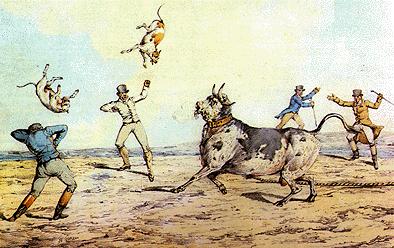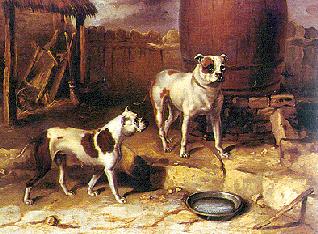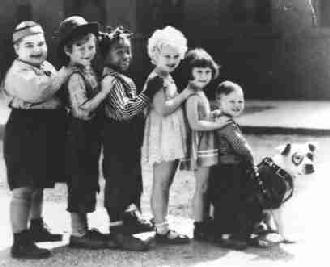03:05 American Pit Bull Terrier History | |
History of the APBT
Even though the APBT has historically been bred to excel in combat with other dogs, a well-bred APBT has a rock-steady temperament and, contrary to popular belief, is NOT inherently aggressive towards humans. However, as adults, some APBTs may show aggression towards other dogs. This fact, along with the APBT's strength and determination, should be taken into account when considering if the APBT is the right breed for you. As with any companion dog, socialization and consistent fair-minded training is a must from a very early age. Although some APBTs may be suspicious of strangers, as most dogs are, and will protect loved ones if necessary, in general they do not excel in protection/guard work. If your main reason for getting a dog is for protection/guard work, perhaps a Rottweiler, German Shephard, or a Doberman Pinscher would suit you better. Or, if you really like the bulldog phenotype, look into an American Bulldog. There are several types of dogs that are commonly called "Pit Bulls." Primarly, these are the American Pit Bull Terrier, the American Staffordshire Terrier (AST), and the Staffordshire Bull Terrier (SBT). All three of these dogs share common ancestry but have been subsequently bred emphasizing different breeding criteria. Due to this divergence, some people feel that they are now different breeds. Others choose to view them as different "strains" of the same breed. Neither view is wrong, as it comes down to how one defines what a "breed" is. This FAQ is primarily about the American Pit Bull Terrier, specifically those dogs of relatively recent game-bred ancestry. Some of the material may ring true for the AST and the SBT, but the authors are biased toward the APBT from performance-bred lines, and this bias will be clear throughout the FAQ. Among enthusiasts, the history of the APBT is as controversial as the breed itself is among the misled public. The breed's history is a recurrent subject of lively debate in the magazines devoted to the breed. In fact, this FAQ was hotly debated among the contributors before it reached its final form, and still everyone isn't 100% happy!
Throughout the 19th century, these dogs were known by a variety of names. "Pit Terriers", "Pit Bull Terriers", "Half and Half's", "Staffordshire Fighting Dogs", "Old Family Dogs"(the Irish name), "Yankee Terriers"(the Northern name), and "Rebel Terriers"(the Southern name) to name a few. In 1898, a man by the name of Chauncy Bennet formed the United Kennel Club (UKC) for the sole purpose of registering "Pit Bull Terriers" as the American Kennel Club wanted nothing to do with them. Originally, he added the word "American" to the name and dropped "Pit". This didn't please all of the people so later the word "Pit" was added back to the name in parentheses as a compromise. The parentheses were then removed from the name about 15 years ago. All other breeds that are registered with UKC were accepted into the UKC after the APBT. Another registry of APBTs is the American Dog Breeders Association (ADBA) which was started in September, 1909 by Guy McCord, a close friend of John P. Colby. Now under the stewardship of the Greenwood family, the ADBA continues to register only APBTs and is more in tune with the APBT as a breed than the UKC. The ADBA does sponsor conformations shows, but more importantly, it sponsors weight pulling competitions which test a dogs strength, stamina, and heart. It also publishes a quarterly magazine dedicated to the APBT called the American Pit Bull Terrier Gazette (see the "References" section). The authors feel that the ADBA is now the flagship registry of APBT as it is doing more to preserve the original characteristics of the breed.
Since 1936, due to different breeding goals, the American Staffordshire Terrier and the American Pit Bull Terrier have diverged in both phenotype and spirit/temperament, although both, ideally, continue to have in common an easy-going, friendly disposition. [2] Some folks in the fancy feel that after 60 years of breeding for different goals, these two dogs are now entirely different breeds. Other people choose to view them as two different strains of the same breed (working and show). Either way, the gap continues to widen as breeders from both sides of the fence consider it undesirable to interbreed the two. To the untrained eye, ASTs may look more impressive and fearsome, with a larger and more blocky head, with bulging jaw muscles, a wider chest and thicker neck. In general, however, they aren't nearly as "game" or athletic as game-bred APBTs. Because of the standardization of their conformation for show purposes, ASTs tend to look alike, to a much greater degree than APBTs do. APBTs have a much wider phenotypical range, since the primary breeding goal, until fairly recently, has been not to produce a dog with a certain "look" but to produce one capable of winning pit contests, in which the looks of a dog counted for nothing. There are some game-bred APBTs that are practically indistinguishable from typical ASTs, but in general they are leaner, leggier, and lighter on their toes and have more stamina, agility, speed, and explosive power. Following the second World War, until the early 1980s, the APBT lapsed into relative obscurity. But those devoted few who knew the breed knew it in intimate detail. These devotees typically knew much more about their dogs' ancestry than about their own--they were often able to recite pedigrees back six or eight generations. When APBTs became popular with the public around 1980, nefarious individuals with little or no knowledge of the breed started to own and breed them and predictably, problems started to crop up. Many of these newcomers did not adhere to the traditional breeding goals of the old-time APBT breeders. In typical backyard fashion they began randomly breeding dogs in order to mass produce puppies as profitable commodities. Worse, some unscrupulous neophytes started selecting dogs for exactly the opposite criteria that had prevailed up to then: they began selectively breeding dogs for the trait of human aggressiveness. Before long, individuals who shouldn't have been allowed near a gold fish were owning and producing poorly bred, human-aggressive "Pit Bulls" for a mass market. This, coupled with the media's propensity for over-simplification and sensationalization, gave rise to the anti-"Pit Bull" hysteria that continues to this day. It should go without saying that, especially with this breed, you should avoid backyard breeders. Find a breeder with a national reputation; investigate, for example, the breeders who advertise in the breed's flagship magazine, The American Pit Bull Terrier Gazette. In spite of the introduction of some bad breeding practices in the last 15 years or so, the vast majority of APBTs remain very human-friendly. The American Canine Temperament Testing Association, which sponsors tests for temperament titles for dogs, reported that 95% of all APBTs that take the test pass, compared with a 77% passing rate for all breeds on average. The APBT's passing rate was the fourth highest of all the breeds tested. Today, the APBT is still used (underground and illegally) as a fighting dog in the United States; pit matches also take place in other countries where there are no laws or where the existing laws are not enforced. However, the vast majority of APBT's--even within the kennels of breeders who breed for fighting ability--never see any action in the pit. Instead they are loyal, loving, companion dogs and family pets. One activity that has really grown in popularity among APBT fanciers is weight pulling contests. Weight-pulls retain something of the spirit of competition of the pit fighting world, but without the blood or sorrow. The APBT is ideally suited for these contests, in which the refusal to quit counts for as much as brute strength. Currently, APBTs hold world records in several weight classes. I have seen one 70-lb. APBT pull a mini-van! Another activity that the APBT is ideally suited for is agility competition, where its athleticism and determination can be widely appreciated. Some APBTs have been trained and done well in Schutzhund sport; these dogs, however, are more the exception than the rule (see the section on APBT's and protection/guard work). [1]- Actually one can trace the "Bulldog" history back further than that, but for this document that's far enough. Readers who are interested in more information on the history of the breed are encouraged to refer to Dr. Carl Semencic's book "The World of Fighting Dogs". [2]- Through out this document, unless otherwise noted, when we refer to the American Pit Bull Terrier(APBT), we are referring to the ADBA version which is more likely to be bred to the traditional APBT breeding standards. In general, the UKC version of the APBT is now being bred mostly for looks alone, and thus has much in common with the AKC AST.
| |
|
| |
| Всего комментариев: 0 | |

 The American Pit Bull Terrier (APBT) is a descendent of the original English bull-baiting Bulldog and has historically been bred with working/performance goals in mind. The challenge of describing the American Pit Bull Terrier inevitably invites a long sequence of superlatives. The APBT is a supremely athletic, highly versatile, adaptive, gushingly affectionate, eager-to-please, all-around family dog. In courage, resolve, indefatigableness, indifference to pain, and stubborn perseverance in overcoming any challenge, the APBT has no equal in the canine world. Although the APBT was once used as a national symbol of courage and pride, the breed is largely misunderstood today.
The American Pit Bull Terrier (APBT) is a descendent of the original English bull-baiting Bulldog and has historically been bred with working/performance goals in mind. The challenge of describing the American Pit Bull Terrier inevitably invites a long sequence of superlatives. The APBT is a supremely athletic, highly versatile, adaptive, gushingly affectionate, eager-to-please, all-around family dog. In courage, resolve, indefatigableness, indifference to pain, and stubborn perseverance in overcoming any challenge, the APBT has no equal in the canine world. Although the APBT was once used as a national symbol of courage and pride, the breed is largely misunderstood today.  Although the precise origin of the APBT is not known, we can reliably trace its roots back at least one hundred and fifty years or so [1] to England. During the late 18th and early 19th centuries the sport of bull-baiting was very much alive and dogs were bred to excel in this endeavor. The same type of dog was also used by hunters to catch game and by butchers and farmers to bring down unruly cattle. These dogs were called "bulldogs." Historically, the word "Bulldog" did not mean a specific breed of dog per se, but rather it was applied to descendants of the ancient Mastiff- type dogs that excelled in the task of bull-baiting. The "bulldogs" of yore were much different from, and should not be confused with, the loveable clowns of the show ring today. The old, performance-bred, working bulldog was closer in phenotype and spirit to the APBT and/or the modern American Bulldog. The use of the word "bulldog" applied to APBT's persists even today among APBT fanciers.
Although the precise origin of the APBT is not known, we can reliably trace its roots back at least one hundred and fifty years or so [1] to England. During the late 18th and early 19th centuries the sport of bull-baiting was very much alive and dogs were bred to excel in this endeavor. The same type of dog was also used by hunters to catch game and by butchers and farmers to bring down unruly cattle. These dogs were called "bulldogs." Historically, the word "Bulldog" did not mean a specific breed of dog per se, but rather it was applied to descendants of the ancient Mastiff- type dogs that excelled in the task of bull-baiting. The "bulldogs" of yore were much different from, and should not be confused with, the loveable clowns of the show ring today. The old, performance-bred, working bulldog was closer in phenotype and spirit to the APBT and/or the modern American Bulldog. The use of the word "bulldog" applied to APBT's persists even today among APBT fanciers.  When bull-baiting was outlawed in England in 1835 the sport of matching two dogs against one another in combat rose in popularity to fill the void. One point of contention about the history of the APBT is whether these pit fighting dogs were essentially a new breed of dog specially created for this popular pastime. Some authors, notably Richard Stratton, have theorized that the APBT is essentially the same breed as the Renaissiance bull-baiting dogs, largely unmixed with any other kind of dog, specifically terriers. These authors consider the present name, American Pit Bull Terrier, a double misnomer, since, in their view, the breed is not of American origin and is not a terrier. They explain the popular attribution of the breed's origin to a cross between bull-baiters and terriers as a retrospective confusion with the breeding history of the English Bull Terrier, which is a totally distinct breed that was never successful at pit fighting but whose origin is well-documented. Other authors who have researched the topic, such as Dr. Carl Semencic, argue that the APBT is indeed the product of a cross between bull-baiting dogs and terriers and that the breed simply did not exist in its current form during the Renaissance. They would argue that when we think of the terriers in the APBT's ancestry, we should not envision modern-day show dogs like Yorkshire Terriers, but instead working terriers (probably now extinct) that were bred for great tenacity in hunting. The problem of proof, which hangs over the discussion of any early breed history, is compounded in this case by the extreme secrecy of the breeders of pit dogs. In the 19th century pedigrees, if committed to paper at all, were not divulged, since every breeder feared letting his rivals in on the secrets of his success and replicating it. In any case, by no later than the mid-19th century, the breed had acquired all of the essential characteristics for which it is still prized today: its awesome athletic abilities, its peerless gameness, and its easy-going temperament.
When bull-baiting was outlawed in England in 1835 the sport of matching two dogs against one another in combat rose in popularity to fill the void. One point of contention about the history of the APBT is whether these pit fighting dogs were essentially a new breed of dog specially created for this popular pastime. Some authors, notably Richard Stratton, have theorized that the APBT is essentially the same breed as the Renaissiance bull-baiting dogs, largely unmixed with any other kind of dog, specifically terriers. These authors consider the present name, American Pit Bull Terrier, a double misnomer, since, in their view, the breed is not of American origin and is not a terrier. They explain the popular attribution of the breed's origin to a cross between bull-baiters and terriers as a retrospective confusion with the breeding history of the English Bull Terrier, which is a totally distinct breed that was never successful at pit fighting but whose origin is well-documented. Other authors who have researched the topic, such as Dr. Carl Semencic, argue that the APBT is indeed the product of a cross between bull-baiting dogs and terriers and that the breed simply did not exist in its current form during the Renaissance. They would argue that when we think of the terriers in the APBT's ancestry, we should not envision modern-day show dogs like Yorkshire Terriers, but instead working terriers (probably now extinct) that were bred for great tenacity in hunting. The problem of proof, which hangs over the discussion of any early breed history, is compounded in this case by the extreme secrecy of the breeders of pit dogs. In the 19th century pedigrees, if committed to paper at all, were not divulged, since every breeder feared letting his rivals in on the secrets of his success and replicating it. In any case, by no later than the mid-19th century, the breed had acquired all of the essential characteristics for which it is still prized today: its awesome athletic abilities, its peerless gameness, and its easy-going temperament.  The immediate ancestors of the APBT were Irish and English pit fighting dogs imported to the States in the mid-19th century. Once in the United States, the breed diverged slightly from what was being produced back in England and Ireland. In America, where these dogs were used not only as pit fighters, but also as catch dogs (i.e., for forcibly retrieving stray hogs and cattle) and as guardians of family, the breeders started producing a slightly larger, leggier dog. However, this gain in size and weight was small until very recently. The Old Family Dogs in 19th century Ireland were rarely above 25 lbs., and 15-lb. dogs were not uncommon. In American books on the breed from the early part of this century, it is rare to find a specimen over 50 lbs. (with a few notable exceptions). From 1900 to 1975 or so, there was probably a very small and gradual increment in the average weight of APBTs over the years, without any corresponding loss in performance abilities. But now that the vast majority of APBTs are no longer performance-bred to the traditional pit standard (understandably, since the traditional performance test, the pit contest itself, is now a felony), the American axiom of "Bigger is Better" has taken over in the breeding practices of the many neophyte breeders who joined the bandwagon of the dog's popularity in the 1980s. This has resulted in a ballooning of the average size of APBTs in the last 15 years--a harmful phenomenon for the breed, in our opinion. Another, less visible modification of the breed since the 19th century was the selective intensification of genetically programmed fighting styles (such as front-end specialists, stifle specialists, etc.), as performance breeding became more sophisticated under competitive pressures. In spite of these changes, there has been a remarkable continuity in the breed for more than a century. Photos from a century ago show dogs indistinguishable from the dogs being bred today. Although, as in any performance breed, you will find a certain lateral (synchronic) variability in phenotype across different lines, you will nevertheless find uncanny chronological continuity in these types across decades. There are photos of pit dogs from the 1860s that are phenotypically (and, to judge by contemporary descriptions of pit matches, constitutionally) identical to the APBTs of today.
The immediate ancestors of the APBT were Irish and English pit fighting dogs imported to the States in the mid-19th century. Once in the United States, the breed diverged slightly from what was being produced back in England and Ireland. In America, where these dogs were used not only as pit fighters, but also as catch dogs (i.e., for forcibly retrieving stray hogs and cattle) and as guardians of family, the breeders started producing a slightly larger, leggier dog. However, this gain in size and weight was small until very recently. The Old Family Dogs in 19th century Ireland were rarely above 25 lbs., and 15-lb. dogs were not uncommon. In American books on the breed from the early part of this century, it is rare to find a specimen over 50 lbs. (with a few notable exceptions). From 1900 to 1975 or so, there was probably a very small and gradual increment in the average weight of APBTs over the years, without any corresponding loss in performance abilities. But now that the vast majority of APBTs are no longer performance-bred to the traditional pit standard (understandably, since the traditional performance test, the pit contest itself, is now a felony), the American axiom of "Bigger is Better" has taken over in the breeding practices of the many neophyte breeders who joined the bandwagon of the dog's popularity in the 1980s. This has resulted in a ballooning of the average size of APBTs in the last 15 years--a harmful phenomenon for the breed, in our opinion. Another, less visible modification of the breed since the 19th century was the selective intensification of genetically programmed fighting styles (such as front-end specialists, stifle specialists, etc.), as performance breeding became more sophisticated under competitive pressures. In spite of these changes, there has been a remarkable continuity in the breed for more than a century. Photos from a century ago show dogs indistinguishable from the dogs being bred today. Although, as in any performance breed, you will find a certain lateral (synchronic) variability in phenotype across different lines, you will nevertheless find uncanny chronological continuity in these types across decades. There are photos of pit dogs from the 1860s that are phenotypically (and, to judge by contemporary descriptions of pit matches, constitutionally) identical to the APBTs of today.  In 1936, thanks to "Pete the Pup" in the "Lil Rascals" and "Our Gang" who familiarized a wider audience with the APBT, the AKC jumped on the bandwagon and registered the breed as the "Staffordshire Terrier". This name was changed to "American Staffordshire Terrier" (AST) in 1972 to distinguish it from its smaller, "froggier", English cousin the Staffordshire Bull Terrier. In 1936, for all intents and purposes, the AKC, UKC, and ADBA version of the "Pit Bull" were identical since the original AKC stock came from pit fighting dogs, which were UKC and ADBA registered. During this time period, and the years that preceded it, the APBT was a well-liked dog in America. At this time the APBT was considered an ideal family pet. Because of his fun-loving, forgiving temperament, the breed was rightly considered an excellent dog for families with small children. Even if most of them couldn't identify the breed by name, kids of the Lil Rascals generation wanted a companion just like "Pete the Pup". During the First World War, there was an American propaganda poster that represented the rival European nations with their national dogs dressed in military uniforms; and in the center representing the United States was an APBT declaring in a caption below: "I'm neutral, but not afraid of any of them."
In 1936, thanks to "Pete the Pup" in the "Lil Rascals" and "Our Gang" who familiarized a wider audience with the APBT, the AKC jumped on the bandwagon and registered the breed as the "Staffordshire Terrier". This name was changed to "American Staffordshire Terrier" (AST) in 1972 to distinguish it from its smaller, "froggier", English cousin the Staffordshire Bull Terrier. In 1936, for all intents and purposes, the AKC, UKC, and ADBA version of the "Pit Bull" were identical since the original AKC stock came from pit fighting dogs, which were UKC and ADBA registered. During this time period, and the years that preceded it, the APBT was a well-liked dog in America. At this time the APBT was considered an ideal family pet. Because of his fun-loving, forgiving temperament, the breed was rightly considered an excellent dog for families with small children. Even if most of them couldn't identify the breed by name, kids of the Lil Rascals generation wanted a companion just like "Pete the Pup". During the First World War, there was an American propaganda poster that represented the rival European nations with their national dogs dressed in military uniforms; and in the center representing the United States was an APBT declaring in a caption below: "I'm neutral, but not afraid of any of them." 